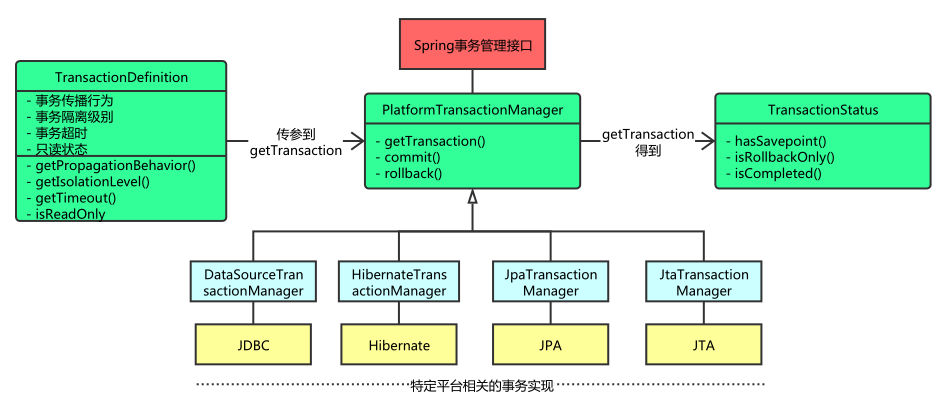Spring事务管理的实现有许多细节,如果对整个接口框架有个大体了解会非常有利于我们理解事务,Spring事务管理涉及的接口的联系如下:

PlatfromTransactionManager是spring事务管理的核心接口
事务的传播性
getPropagationBehavior()返回事务的传播行为,由是否有一个活动的事务来决定一个事务调用。 在TransactionDefinition接口中定义了七个事务传播行为。
配置方式:
@Transactional(propagation=Propagation.REQUIRED) //默认方式,跟@Transactional同效果PROPAGATION_REQUIRED 表示业务方法需要在一个事务中处理,如果业务方法执行时已经在一个事务中,则加入该事务,否则重新开启一个事务。这也是默认的事务传播行为;
PROPAGATION_SUPPORTS 如果业务方法在一个既有的事务中进行,则加入该事务;否则,业务方法将在一个没有事务的环境下进行;
PROPAGATION_MANDATORY(mandatory,强制的) 该属性指定业务方法只能在一个已经存在的事务中进行,业务方法不能发起自己的事务;如果业务方法没有在一个既有的事务中进行,容器将抛出异常;
PROPAGATION_REQUIRES_NEW 表明业务方法需要在一个单独的事务中进行,如果业务方法进行时已经在一个事务中,则这个事务被挂起,并重新开启一个事务来执行这个业务方法,业务方法执行完毕后,原来的事务恢复进行;
PROPAGATION_NOT_SUPPORTED 总是非事务地执行,并挂起任何存在的事务。
PROPAGATION_NEVER 总是非事务地执行,如果存在一个活动事务,则抛出异常。
PROPAGATION_NESTED 该属性指定,如果业务方法在一个既有的事务中执行,则该业务方法将在一个嵌套的事务中进行;否则,按照TransactionDefinition.PROPAGATION_REQUIRED来对待。它使用一个单独的事务,这个事务可以有多个rollback点,内部事务的rollback对外部事务没有影响,但外部事务的rollback会导致内部事务的rollback。这个行为只对DataSourceTransactionManager有效
1.1 PROPAGATION_REQUIRED
//事务属性 PROPAGATION_REQUIRED
@Transactional(propagation=Propagation.REQUIRED)
methodA{
……
methodB();
……
}
//事务属性 PROPAGATION_REQUIRED
@Transactional(propagation=Propagation.REQUIRED)
methodB{
……
}单独调用MethodB时,Spring保证在methodB方法中所有的调用都获得到一个相同的连接。在调用methodB时,没有一个存在的事务,所以获得一个新的连接,开启了一个新的事务。
调用MethodA时,环境中没有事务,所以开启一个新的事务. 当在MethodA中调用MethodB时,环境中已经有了一个事务,所以methodB就加入当前事务。 相当于把B方法直接移到A方法中,同时回滚或者同时提交。
1.2 PROPAGATION_SUPPORTS
//事务属性 PROPAGATION_REQUIRED
@Transactional(propagation=Propagation.REQUIRED)
methodA{
……
methodB();
……
}
//事务属性 PROPAGATION_SUPPORTS
@Transactional(propagation=Propagation.SUPPORTS)
methodB{
……
}单独调用MethodB时,methodB方法是非事务的执行的。
调用MethodA时,methodB则加入到了methodA的事务中,事务地执行。
1.3 PROPAGATION_MANDATORY
//事务属性 PROPAGATION_REQUIRED
@Transactional(propagation=Propagation.REQUIRED)
methodA{
……
methodB();
……
}
//事务属性 PROPAGATION_MANDATORY
@Transactional(propagation=Propagation.MANDATORY)
methodB{
……
}当单独调用methodB时,因为当前没有一个活动的事务,则会抛出异常 throw new IllegalTransactionStateException("Transactionpropagation 'mandatory' but no existing transaction found");
当调用methodA时,methodB则加入到methodA的事务中,事务地执行。
1.4 PROPAGATION_REQUIRES_NEW
//事务属性 PROPAGATION_REQUIRED
@Transactional(propagation=Propagation.REQUIRED)
methodA{
doSomeThingA();
methodB();
doSomeThingB();
}
//事务属性 PROPAGATION_REQUIRES_NEW
@Transactional(propagation=Propagation.REQUIRES_NEW)
methodB{
……
}当单独调用methodB时,相当于把methodB声明为REQUIRED。开启一个新的事务,事务地执行。
当调用methodA时,类似如下效果:
main(){
TransactionManager tm = null;
try{
//获得一个JTA事务管理器
tm = getTransactionManager();
tm.begin();//开启一个新的事务
Transaction ts1 = tm.getTransaction();
doSomeThing();
tm.suspend();//挂起当前事务
try{
tm.begin();//重新开启第二个事务
Transaction ts2 = tm.getTransaction();
methodB();
ts2.commit();//提交第二个事务
}Catch(RunTimeException ex){
ts2.rollback();//回滚第二个事务
}finally{
//释放资源
}
//methodB执行完后,恢复第一个事务
tm.resume(ts1);
doSomeThingB();
ts1.commit();//提交第一个事务
}catch(RunTimeException ex){
ts1.rollback();//回滚第一个事务
}finally{
//释放资源
}
}在这里,我把ts1称为外层事务,ts2称为内层事务。从上面的代码可以看出,ts2与ts1是两个独立的事务,互不相干。Ts2是否成功并不依赖于ts1。如果methodA方法在调用methodB方法后的doSomeThingB方法失败了,而methodB方法所做的结果依然被提交。而除了methodB之外的其它代码导致的结果却被回滚了。
使用PROPAGATION_REQUIRES_NEW,需要使用JtaTransactionManager作为事务管理器。
注意:
@Transactional(propagation = Propagation.REQUIRED)
@Override
public void save() {
method1();
User user = new User("A");
userMapper.insertSelective(user);
if (true) {
throw new RuntimeException("save 抛异常了");
}
}
@Transactional(propagation = Propagation.REQUIRES_NEW)
public void method1() {
User user = new User("B");
userMapper.insertSelective(user);
}运行之后,发现数据并没有插入数据库。查看日志内容。

从日志内容可以看出,其实两个方法都是处于同一个事务中,method1 方法并没有创建一个新的事务。根据 Spring 官方文档:

In proxy mode (which is the default), only external method calls coming in through the proxy are intercepted. This means that self-invocation, in effect, a method within the target object calling another method of the target object, will not lead to an actual transaction at runtime even if the invoked method is marked with @Transactional.
大概意思:在默认的代理模式下,只有目标方法由外部调用,才能被 Spring 的事务拦截器拦截。在同一个类中的两个方法直接调用,是不会被 Spring 的事务拦截器拦截,就像上面的 save 方法直接调用了同一个类中的 method1方法,method1 方法不会被 Spring 的事务拦截器拦截。可以使用 AspectJ 取代 Spring AOP 代理来解决这个问题,但是这里暂不讨论。
为了解决这个问题,我们可以新建一个类。
@Service
public class OtherServiceImpl implements OtherService {
@Autowired
private UserMapper userMapper;
@Transactional(propagation = Propagation.REQUIRES_NEW)
@Override
public void method1() {
User user = new User("XXXXX");
userMapper.insertSelective(user);
}
}然后在 save 方法中调用 otherService.method1 方法。
@Autowired
private OtherService otherService;
@Transactional(propagation = Propagation.REQUIRED)
@Override
public void save() {
otherService.method1();
User user = new User("YYYYY");
userMapper.insertSelective(user);
if (true) {
throw new RuntimeException("save 抛异常了");
}
}这下,otherService.method1 方法的数据插入成功,save 方法的数据未插入,事务回滚。

从日志可以看出,首先创建了 save 方法的事务,由于 otherService.method1 方法的 @Transactional 的 propagation 属性为 Propagation.REQUIRES_NEW ,所以接着暂停了 save 方法的事务,重新创建了 otherService.method1 方法的事务,接着 otherService.method1 方法的事务提交,接着 save 方法的事务回滚。这就印证了只有目标方法由外部调用,才能被 Spring 的事务拦截器拦截。
1.5 PROPAGATION_NOT_SUPPORTED
//事务属性 PROPAGATION_REQUIRED
@Transactional(propagation=Propagation.REQUIRED)
methodA{
doSomeThingA();
methodB();
doSomeThingB();
}
//事务属性 PROPAGATION_NOT_SUPPORTED
Transactional(propagation=Propagation.NOT_SUPPORTED)
methodB{
……
}当单独调用methodB时,不启用任何事务机制,非事务地执行。
当调用methodA时,相当于下面的效果:
main(){
TransactionManager tm = null;
try{
//获得一个JTA事务管理器
tm = getTransactionManager();
tm.begin();//开启一个新的事务
Transaction ts1 = tm.getTransaction();
doSomeThingA();
tm.suspend();//挂起当前事务
methodB();
//methodB执行完后,恢复第一个事务
tm.resume(ts1);
doSomeThingB();
ts1.commit();//提交第一个事务
}catch(RunTimeException ex){
ts1.rollback();//回滚第一个事务
}finally{
//释放资源
}
}使用PROPAGATION_NOT_SUPPORTED,也需要使用JtaTransactionManager作为事务管理器。
1.6 PROPAGATION_NEVER
//事务属性 PROPAGATION_REQUIRED
@Transactional(propagation=Propagation.REQUIRED)
methodA{
doSomeThingA();
methodB();
doSomeThingB();
}
//事务属性 PROPAGATION_NEVER
Transactional(propagation=Propagation.NEVER)
methodB{
……
}单独调用methodB,则非事务的执行。
调用methodA则会抛出异常throw new IllegalTransactionStateException("Transaction propagation 'never' butexisting transaction found");
1.7 PROPAGATION_NESTED
内层事务依赖于外层事务
这是一个嵌套事务,使用JDBC 3.0驱动时,仅仅支持DataSourceTransactionManager作为事务管理器。需要JDBC 驱动的java.sql.Savepoint类。有一些JTA的事务管理器实现可能也提供了同样的功能。
使用PROPAGATION_NESTED,还需要把PlatformTransactionManager的 nestedTransactionAllowed 属性设为true; 而nestedTransactionAllowed属性值默认为false;
//事务属性 PROPAGATION_REQUIRED
@Transactional(propagation=Propagation.REQUIRED)
methodA{
doSomeThingA();
methodB();
doSomeThingB();
}
//事务属性 PROPAGATION_NESTED
Transactional(propagation=Propagation.NESTED)
methodB{
……
}如果单独调用methodB方法,则按REQUIRED属性执行。
如果调用methodA方法,相当于下面的效果:
main(){
Connection con = null;
Savepoint savepoint = null;
try{
con = getConnection();
con.setAutoCommit(false);
doSomeThingA();
savepoint = con2.setSavepoint();
try{
methodB();
}catch(RuntimeException ex){
con.rollback(savepoint);
}finally{
//释放资源
}
doSomeThingB();
con.commit();
}catch(RuntimeException ex){
con.rollback();
}finally{
//释放资源
}
}当methodB方法调用之前,调用setSavepoint方法,保存当前的状态到savepoint。如果methodB方法调用失败,则恢复到之前保存的状态。但是需要注意的是,这时的事务并没有进行提交,如果后续的代码(doSomeThingB()方法)调用失败,则回滚包括methodB方法的所有操作。
嵌套事务一个非常重要的概念就是内层事务依赖于外层事务。外层事务失败时,会回滚内层事务所做的动作。而内层事务操作失败并不会引起外层事务的回滚。
PROPAGATION_NESTED与PROPAGATION_REQUIRES_NEW的区别:
相同点:都是一个嵌套事务,如果不存在一个活动的事务,都会开启一个新的事务。使用PROPAGATION_REQUIRES_NEW时,内层事务与外层事务就像两个独立的事务一样,一旦内层事务进行了提交后,外层事务不能对其进行回滚。两个事务互不影响。两个事务不是一个真正的嵌套事务。同时它需要JTA事务管理器的支持。
不同点:使用PROPAGATION_NESTED时,外层事务的回滚可以引起内层事务的回滚。而内层事务的异常并不会导致外层事务的回滚,它是一个真正的嵌套事务。DataSourceTransactionManager使用savepoint支持PROPAGATION_NESTED时,需要JDBC 3.0以上驱动及1.4以上的JDK版本支持。其它的JTA TrasactionManager实现可能有不同的支持方式。
注意事项
1、Transactional的异常控制,默认是Check Exception 不回滚,unCheck Exception回滚;
2、如果配置了rollbackFor 和 noRollbackFor 且两个都是用同样的异常,那么遇到该异常,还是回滚;
3、rollbackFor 和noRollbackFor 配置也许不会含盖所有异常,对于遗漏的按照Check Exception 不回滚,unCheck Exception回滚;
4、@Transactional只能被应用到public方法上, 对于其它非public的方法,如果标记了@Transactional也不会报错,但方法没有事务功能.
5、Spring使用声明式事务处理,默认情况下,如果被注解的数据库操作方法中发生了unchecked异常,所有的数据库操作将rollback;如果发生的异常是checked异常,默认情况下数据库操作还是会提交的。这种默认的行为是可以改变的。使用@Transactional注解的noRollbackFor和rollbackFor属性:
如:@Transactional(rollbackFor=Exception.class)可以使checked异常发生时,数据库操作也rollback、@Transactional(noRollbackFor=RuntimeException.class)可以使unchecked异常发生时也提交数据库操作。
6、可以使用noRollbackForClassName、rollbackForClassName属性来指定一个异常类名的String数组来改变默认的行为。
7、读取数据库中的数据时是不需要事务管理的,这种情况下可以使用事务的传播行为来告诉Spring不需要开启事务,如:@Transactional(propagation =Propagation.NOT_SUPPORTED)。
声明式事务的配置方式
根据代理机制的不同,总结了五种Spring事务的配置方式,配置文件如下:
1、XML配置每个Bean都有一个代理:
<?xml version="1.0" encoding="UTF-8"?>
<beans xmlns="http://www.springframework.org/schema/beans"
xmlns:xsi="http://www.w3.org/2001/XMLSchema-instance"
xmlns:context="http://www.springframework.org/schema/context"
xmlns:aop="http://www.springframework.org/schema/aop"
xsi:schemaLocation="http://www.springframework.org/schema/beans
http://www.springframework.org/schema/beans/spring-beans-2.5.xsd
http://www.springframework.org/schema/context
http://www.springframework.org/schema/context/spring-context-2.5.xsd
http://www.springframework.org/schema/aop http://www.springframework.org/schema/aop/spring-aop-2.5.xsd">
<bean id="sessionFactory"
class="org.springframework.orm.hibernate3.LocalSessionFactoryBean">
<property name="configLocation" value="classpath:hibernate.cfg.xml" />
<property name="configurationClass" value="org.hibernate.cfg.AnnotationConfiguration" />
</bean>
<!-- 定义事务管理器(声明式的事务) -->
<bean id="transactionManager"
class="org.springframework.orm.hibernate3.HibernateTransactionManager">
<property name="sessionFactory" ref="sessionFactory" />
</bean>
<!-- 配置DAO -->
<bean id="userDaoTarget" class="com.bluesky.spring.dao.UserDaoImpl">
<property name="sessionFactory" ref="sessionFactory" />
</bean>
<bean id="userDao"
class="org.springframework.transaction.interceptor.TransactionProxyFactoryBean">
<!-- 配置事务管理器 -->
<property name="transactionManager" ref="transactionManager" />
<property name="target" ref="userDaoTarget" />
<property name="proxyInterfaces" value="com.bluesky.spring.dao.GeneratorDao" />
<!-- 配置事务属性 -->
<property name="transactionAttributes">
<props>
<prop key="*">PROPAGATION_REQUIRED</prop>
</props>
</property>
</bean>
</beans>2、XML所有Bean共享一个代理基类:
<?xml version="1.0" encoding="UTF-8"?>
<beans xmlns="http://www.springframework.org/schema/beans"
xmlns:xsi="http://www.w3.org/2001/XMLSchema-instance"
xmlns:context="http://www.springframework.org/schema/context"
xmlns:aop="http://www.springframework.org/schema/aop"
xsi:schemaLocation="http://www.springframework.org/schema/beans
http://www.springframework.org/schema/beans/spring-beans-2.5.xsd
http://www.springframework.org/schema/context
http://www.springframework.org/schema/context/spring-context-2.5.xsd
http://www.springframework.org/schema/aop http://www.springframework.org/schema/aop/spring-aop-2.5.xsd">
<bean id="sessionFactory"
class="org.springframework.orm.hibernate3.LocalSessionFactoryBean">
<property name="configLocation" value="classpath:hibernate.cfg.xml" />
<property name="configurationClass" value="org.hibernate.cfg.AnnotationConfiguration" />
</bean>
<!-- 定义事务管理器(声明式的事务) -->
<bean id="transactionManager"
class="org.springframework.orm.hibernate3.HibernateTransactionManager">
<property name="sessionFactory" ref="sessionFactory" />
</bean>
<!-- 此处所有transactionBase所有Bean共用 -->
<bean id="transactionBase"
class="org.springframework.transaction.interceptor.TransactionProxyFactoryBean"
lazy-init="true" abstract="true">
<!-- 配置事务管理器 -->
<property name="transactionManager" ref="transactionManager" />
<!-- 配置事务属性 -->
<property name="transactionAttributes">
<props>
<prop key="*">PROPAGATION_REQUIRED</prop>
</props>
</property>
</bean>
<!-- 配置DAO -->
<bean id="userDaoTarget" class="com.bluesky.spring.dao.UserDaoImpl">
<property name="sessionFactory" ref="sessionFactory" />
</bean>
<bean id="userDao" parent="transactionBase" >
<property name="target" ref="userDaoTarget" />
</bean>
</beans>3、XML配置拦截器:
<?xml version="1.0" encoding="UTF-8"?>
<beans xmlns="http://www.springframework.org/schema/beans"
xmlns:xsi="http://www.w3.org/2001/XMLSchema-instance"
xmlns:context="http://www.springframework.org/schema/context"
xmlns:aop="http://www.springframework.org/schema/aop"
xsi:schemaLocation="http://www.springframework.org/schema/beans
http://www.springframework.org/schema/beans/spring-beans-2.5.xsd
http://www.springframework.org/schema/context
http://www.springframework.org/schema/context/spring-context-2.5.xsd
http://www.springframework.org/schema/aop http://www.springframework.org/schema/aop/spring-aop-2.5.xsd">
<bean id="sessionFactory"
class="org.springframework.orm.hibernate3.LocalSessionFactoryBean">
<property name="configLocation" value="classpath:hibernate.cfg.xml" />
<property name="configurationClass" value="org.hibernate.cfg.AnnotationConfiguration" />
</bean>
<!-- 定义事务管理器(声明式的事务) -->
<bean id="transactionManager"
class="org.springframework.orm.hibernate3.HibernateTransactionManager">
<property name="sessionFactory" ref="sessionFactory" />
</bean>
<bean id="transactionInterceptor"
class="org.springframework.transaction.interceptor.TransactionInterceptor">
<property name="transactionManager" ref="transactionManager" />
<!-- 配置事务属性 -->
<property name="transactionAttributes">
<props>
<prop key="*">PROPAGATION_REQUIRED</prop>
</props>
</property>
</bean>
<bean class="org.springframework.aop.framework.autoproxy.BeanNameAutoProxyCreator">
<property name="beanNames">
<list>
<value>*Dao</value>
</list>
</property>
<property name="interceptorNames">
<list>
<value>transactionInterceptor</value>
</list>
</property>
</bean>
<!-- 配置DAO -->
<bean id="userDao" class="com.bluesky.spring.dao.UserDaoImpl">
<property name="sessionFactory" ref="sessionFactory" />
</bean>
</beans>4、XML使用tx标签配置AOP切面:
<?xml version="1.0" encoding="UTF-8"?>
<beans xmlns="http://www.springframework.org/schema/beans"
xmlns:xsi="http://www.w3.org/2001/XMLSchema-instance"
xmlns:context="http://www.springframework.org/schema/context"
xmlns:aop="http://www.springframework.org/schema/aop"
xmlns:tx="http://www.springframework.org/schema/tx"
xsi:schemaLocation="http://www.springframework.org/schema/beans
http://www.springframework.org/schema/beans/spring-beans-2.5.xsd
http://www.springframework.org/schema/context
http://www.springframework.org/schema/context/spring-context-2.5.xsd
http://www.springframework.org/schema/aop http://www.springframework.org/schema/aop/spring-aop-2.5.xsd
http://www.springframework.org/schema/tx http://www.springframework.org/schema/tx/spring-tx-2.5.xsd">
<context:annotation-config />
<context:component-scan base-package="com.bluesky" />
<bean id="sessionFactory"
class="org.springframework.orm.hibernate3.LocalSessionFactoryBean">
<property name="configLocation" value="classpath:hibernate.cfg.xml" />
<property name="configurationClass" value="org.hibernate.cfg.AnnotationConfiguration" />
</bean>
<!-- 定义事务管理器(声明式的事务) -->
<bean id="transactionManager"
class="org.springframework.orm.hibernate3.HibernateTransactionManager">
<property name="sessionFactory" ref="sessionFactory" />
</bean>
<tx:advice id="txAdvice" transaction-manager="transactionManager">
<tx:attributes>
<tx:method name="*" propagation="REQUIRED" />
</tx:attributes>
</tx:advice>
<aop:config>
<aop:pointcut id="interceptorPointCuts"
expression="execution(* com.bluesky.spring.dao.*.*(..))" />
<aop:advisor advice-ref="txAdvice"
pointcut-ref="interceptorPointCuts" />
</aop:config>
</beans>5、全注解方式:
<?xml version="1.0" encoding="UTF-8"?>
<beans xmlns="http://www.springframework.org/schema/beans"
xmlns:xsi="http://www.w3.org/2001/XMLSchema-instance"
xmlns:context="http://www.springframework.org/schema/context"
xmlns:aop="http://www.springframework.org/schema/aop"
xmlns:tx="http://www.springframework.org/schema/tx"
xsi:schemaLocation="http://www.springframework.org/schema/beans
http://www.springframework.org/schema/beans/spring-beans-2.5.xsd
http://www.springframework.org/schema/context
http://www.springframework.org/schema/context/spring-context-2.5.xsd
http://www.springframework.org/schema/aop http://www.springframework.org/schema/aop/spring-aop-2.5.xsd
http://www.springframework.org/schema/tx http://www.springframework.org/schema/tx/spring-tx-2.5.xsd">
<context:annotation-config />
<context:component-scan base-package="com.bluesky" />
<tx:annotation-driven transaction-manager="transactionManager"/>
<bean id="sessionFactory"
class="org.springframework.orm.hibernate3.LocalSessionFactoryBean">
<property name="configLocation" value="classpath:hibernate.cfg.xml" />
<property name="configurationClass" value="org.hibernate.cfg.AnnotationConfiguration" />
</bean>
<!-- 定义事务管理器(声明式的事务) -->
<bean id="transactionManager"
class="org.springframework.orm.hibernate3.HibernateTransactionManager">
<property name="sessionFactory" ref="sessionFactory" />
</bean>
</beans>或者SpringBoot在Application启动类通过注解开启事务管理:
@EnableTransactionManagement // 启注解事务管理,等同于xml配置方式的 <tx:annotation-driven />然后在具体的DAO类中添加注解@Transaction
package com.bluesky.spring.dao;
import java.util.List;
import org.hibernate.SessionFactory;
import org.springframework.beans.factory.annotation.Autowired;
import org.springframework.orm.hibernate3.support.HibernateDaoSupport;
import org.springframework.stereotype.Component;
import com.bluesky.spring.domain.User;
@Transactional
@Component("userDao")
public class UserDaoImpl extends HibernateDaoSupport implements UserDao {
public List<User> listUsers() {
return this.getSession().createQuery("from User").list();
}
}

